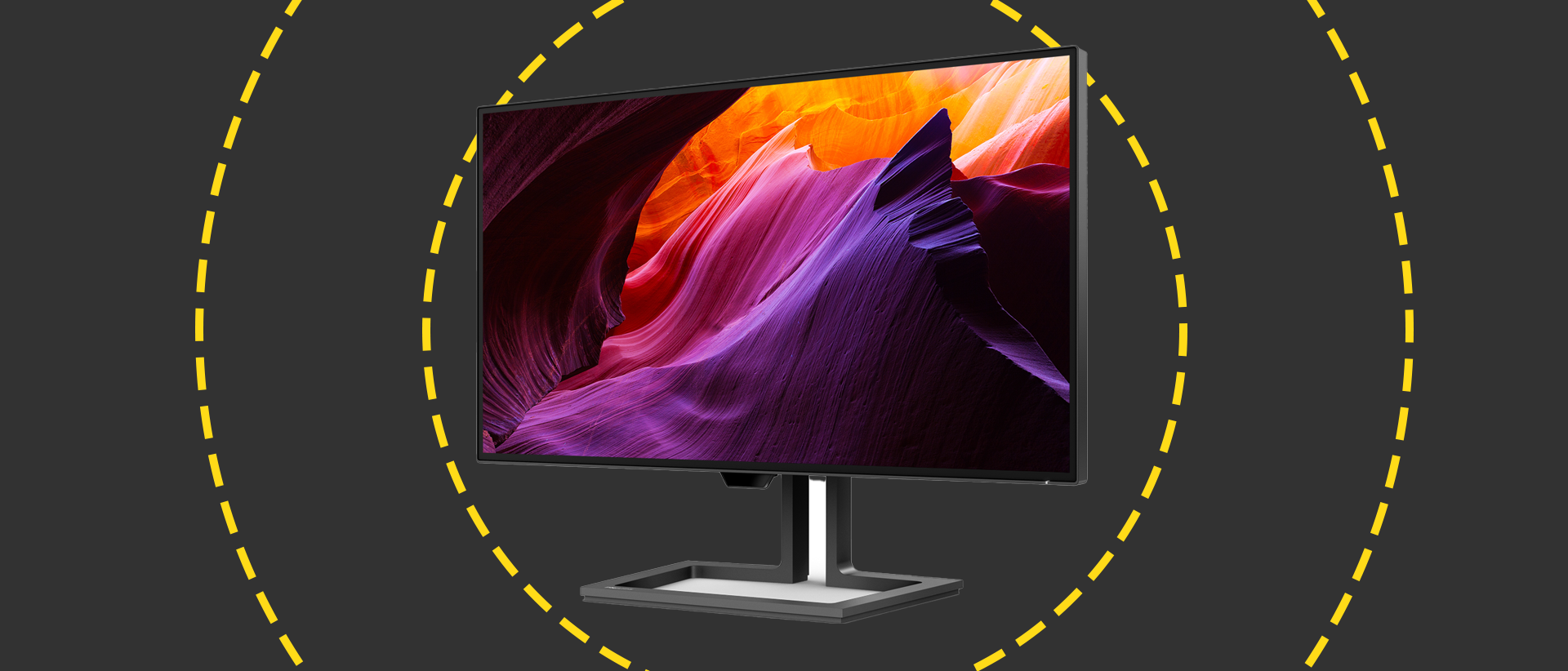Philips 27B1U7903 review: Spectacular display and price
One of those products where if you have to ask the price then you can't afford it, but the quality is outstanding

-
+
Spectacular 4K resolution
-
+
Thunderbolt 4 connection
-
-
Expensive

Normally we might struggle to write a full-page review about a monitor. Not this time. Every cutting-edge technology we can think of is included in the Philips 27B1U7903, and the result is as awe-inspiring as it is expensive.
Let's start with mini LEDs. Rather than the strips of LED lighting that normally illuminate IPS panels, tiny individual LEDs allow Philips to provide a far more uniform and controllable backlight. There are 2,304 lighting zones here, and Philips can pump up the brightness to 1,400cd/m2 in localised areas.
Without wishing to lapse into hyperbole, it looks spectacular. we've watched the intro to the Frozen Worlds episode from Our Planet to test HDR performance on many different monitors, but this is the first time we've made an "ooh" sound as the sunlight catches the ice. It's no coincidence that the Philips 27B1U7903 is the first monitor we've tested to support VESA's DisplayHDR 1400 certification.
Part of the reason it looks so spectacular is the 4K resolution. When packed into a 27in panel, that translates into incredible levels of detail: at 163 dots per inch, everything from photos to Excel documents looks pin sharp.
The final noteworthy inclusion is Thunderbolt 4. Philips has paid extra for this feature when it could have stuck with USB 4 or Thunderbolt 3 (both of which have the same bandwidth, 40Gbits/sec), and it did so for guaranteed compatibility. It doesn't matter whether you own an old MacBook with a Thunderbolt 3 output or a Windows laptop with a USB-C 3.2 connector, using the supplied cable will work -- and it can charge at up to 90W. However, Philips could have been more generous with the supplied cable, as it only measures 80cm when Thunderbolt 4 supports up to 2m.
Another reason to choose Thunderbolt 4 is that it can daisy-chain two 4K monitors at 60Hz. Or you can take advantage of this monitor's other inputs for a multi-PC system – it supports picture-by-picture – with one DisplayPort and two HDMI 2 ports at the rear.
Anyone seeking a fully featured docking monitor will be pleased to see a gigabit Ethernet port. Thanks to the second Thunderbolt 4 output (which provides up to 15W) and four USB-A ports, this monitor can be used as a glorified docking station.
One of the drawbacks of mini LEDs compared to strip LEDs is that they eat electricity, and such a feature-packed screen requires processing firepower inside. We saw a peak draw of 144W, and typical consumption of around 100W when watching HDR videos. It makes sense to drop the brightness down if you're not looking at the screen, which is what happens if you activate the presence sensor.
All these features would be for nought if the image quality wasn't up to scratch, but that was never in doubt thanks to the combination of an IPS panel and Quantum Dot technology. What we were surprised by was how well-matched the colour presets were: DCI-P3 mode covered 91% of its gamut, Adobe RGB mode 94%, sRGB 92%. And all with minimal overspill, so if you choose a colour space then that's what this display will stick to.
Contrast is excellent, averaging at 4,500:1 across our tests, and even in SDR mode the 27B1U7903 can go up to 865cd/m2 . It had one blemish on its scorecard, with an average Delta E of 0.9 and a peak of 2.85. Print designers and photographers who rely on accuracy should stick with a screen such as the Eizo ColorEdge CG279X. But that 27in 1440p monitor costs over £1,700.
We have some other minor niggles. The pair of 3W speakers are better than those found on most monitors, but don't have enough weight to do justice to the spectacular images. Nor are we a fan of the OSD, with buttons placed awkwardly behind the panel. You can download Philips' SmartControl app to change settings as well, but this is clunky.
It's hard to justify spending this much on a 27in monitor when you can buy, say, the 32in MSI Summit MS321UP for £700. But the Philips literally outshines every other monitor we've tested. If you'll take advantage of its features, particularly its support for HDR 1400, then it's worth every penny.
Philips 27B1U7903 specifications
| Screen size | 27in |
| Screen type | LED IPS panel (60Hz) |
| Resolution | 3,840 x 2,160 |
| Ports | DisplayPort 1.4, 2 x HDMI, 2.0 Thunderbolt 4, input (90W power delivery) Thunderbolt 4, output (15W power delivery) 4-port USB-A, 3.2 Gen 2 hub gigabit Ethernet |
| Dimensions (WDH) | 613 x 204 x 515-645mm |
| Weight | 9..4Kg |
| Warranty | 2yr warranty |
Get the ITPro daily newsletter
Sign up today and you will receive a free copy of our Future Focus 2025 report - the leading guidance on AI, cybersecurity and other IT challenges as per 700+ senior executives
Tim Danton is editor-in-chief of PC Pro, the UK's biggest selling IT monthly magazine. He specialises in reviews of laptops, desktop PCs and monitors, and is also author of a book called The Computers That Made Britain.
You can contact Tim directly at editor@pcpro.co.uk.
-
 ‘Phishing kits are a force multiplier': Cheap cyber crime kits can be bought on the dark web for less than $25 – and experts warn it’s lowering the barrier of entry for amateur hackers
‘Phishing kits are a force multiplier': Cheap cyber crime kits can be bought on the dark web for less than $25 – and experts warn it’s lowering the barrier of entry for amateur hackersNews Research from NordVPN shows phishing kits are now widely available on the dark web and via messaging apps like Telegram, and are often selling for less than $25.
By Emma Woollacott Published
-
 Redis unveils new tools for developers working on AI applications
Redis unveils new tools for developers working on AI applicationsNews Redis has announced new tools aimed at making it easier for AI developers to build applications and optimize large language model (LLM) outputs.
By Ross Kelly Published
-
 Google layoffs continue with "hundreds" cut from Chrome, Android, and Pixel teams
Google layoffs continue with "hundreds" cut from Chrome, Android, and Pixel teamsNews The tech giant's efficiency drive enters a third year with devices teams the latest target
By Bobby Hellard Published